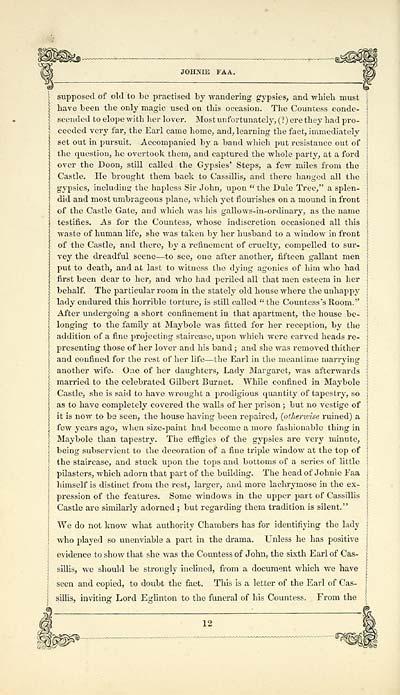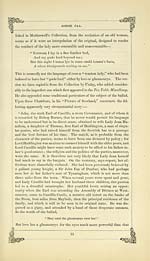Glen Collection of printed music > Printed text > Ballads and songs of Ayrshire > Volume 1
(18) Page 12
Download files
Complete book:
Complete section:
Individual page:
Thumbnail gallery: Grid view | List view

JOHNIE FAA.
supposed of old to be practised by wandering gypsies, and -which must
have been the only magic used on this occasion. The Countess conde-
scended to elope with her lover. Most unfortunately, (?) ere they had pro-
ceeded very far, the Earl came home, and, learning the fact, immediately
set out in pursuit. Accompanied by a band which put resistance out of
the question, he overtook them, and captured the whole party, at a ford
over the Doon, still called the Gypsies' Steps, a few miles from the
Castle. He brought them back to Cassillis, and there hanged all the
gypsies, including the hajDless Sir John, iipon " the Dule Tree," a splen-
did and most umbrageous plane, which yet flourishes on a mound in front
of the Castle Gate, and which was his gallows-in-ordinary, as the name
testifies. As for the Countess, whose indiscretion occasioned all this
waste of human life, she was taken by her husband to a window in front
of the Castle, and there, by a refinement of cruelty, compelled to sur-
vey the dreadful scene — to see, one after another, fifteen gallant men
put to death, and at last to witness the dying agonies of him who had
first been dear to her, and who had periled all that men esteem in her
behalf. The particular room in the stately old house where the unhappy
lady endured this horrible torture, is still called "the Countess's Room."
After undergoing a short confinement in that apartment, the house be-
longing to the family at Maybole was fitted for her reception, by the
addition of a fine projecting staircase, upon which were carved heads re-
presenting those of her lover and his band ; and she was removed thither
and confined for the rest of her life — the Earl in the meantime marrying
another wife. One of her daughters. Lady Margaret, was afterwards
married to the celebrated Gilbert Burnet. While confined in Maybole
Castle, she is said to have wrought a i^rodigious quantity of tapestry, so
as to have completely covered the walls of her jDrison ; but no vestige of
it is now to bs seen, the house having been repaired, {othenvise ruined) a
few years ago, Avhen size-paint had become a more fashionable thing in
Maybole than tapestry. The efiigies of the gypsies are very minute,
being subservient to the decoration of a fine triple window at the top of
the staircase, and stuck upon the tops and bottoms of a series of little
pilasters, which adorn that part of the building. The head of Johnie Faa
himself is distinct from the rest, larger, and more lachrymose in the ex-
pression of the features. Some windows in the upper part of Cassillis
Castle are similarly adorned ; but regarding them tradition is silent."
We do not know what authority Chambers has for identifiying the lady
who played so unenviable a part in the drama. Unless he has positive
evidence to show that she was the Countess of John, the sixth Earl of Cas-
sillis, we should be strongly inchned, from a document which we have
seen and copied, to doubt the fact. This is a letter of the Earl of Cas-
sillis, inviting Lord Eglinton to the funeral of his Countess. From the
12
supposed of old to be practised by wandering gypsies, and -which must
have been the only magic used on this occasion. The Countess conde-
scended to elope with her lover. Most unfortunately, (?) ere they had pro-
ceeded very far, the Earl came home, and, learning the fact, immediately
set out in pursuit. Accompanied by a band which put resistance out of
the question, he overtook them, and captured the whole party, at a ford
over the Doon, still called the Gypsies' Steps, a few miles from the
Castle. He brought them back to Cassillis, and there hanged all the
gypsies, including the hajDless Sir John, iipon " the Dule Tree," a splen-
did and most umbrageous plane, which yet flourishes on a mound in front
of the Castle Gate, and which was his gallows-in-ordinary, as the name
testifies. As for the Countess, whose indiscretion occasioned all this
waste of human life, she was taken by her husband to a window in front
of the Castle, and there, by a refinement of cruelty, compelled to sur-
vey the dreadful scene — to see, one after another, fifteen gallant men
put to death, and at last to witness the dying agonies of him who had
first been dear to her, and who had periled all that men esteem in her
behalf. The particular room in the stately old house where the unhappy
lady endured this horrible torture, is still called "the Countess's Room."
After undergoing a short confinement in that apartment, the house be-
longing to the family at Maybole was fitted for her reception, by the
addition of a fine projecting staircase, upon which were carved heads re-
presenting those of her lover and his band ; and she was removed thither
and confined for the rest of her life — the Earl in the meantime marrying
another wife. One of her daughters. Lady Margaret, was afterwards
married to the celebrated Gilbert Burnet. While confined in Maybole
Castle, she is said to have wrought a i^rodigious quantity of tapestry, so
as to have completely covered the walls of her jDrison ; but no vestige of
it is now to bs seen, the house having been repaired, {othenvise ruined) a
few years ago, Avhen size-paint had become a more fashionable thing in
Maybole than tapestry. The efiigies of the gypsies are very minute,
being subservient to the decoration of a fine triple window at the top of
the staircase, and stuck upon the tops and bottoms of a series of little
pilasters, which adorn that part of the building. The head of Johnie Faa
himself is distinct from the rest, larger, and more lachrymose in the ex-
pression of the features. Some windows in the upper part of Cassillis
Castle are similarly adorned ; but regarding them tradition is silent."
We do not know what authority Chambers has for identifiying the lady
who played so unenviable a part in the drama. Unless he has positive
evidence to show that she was the Countess of John, the sixth Earl of Cas-
sillis, we should be strongly inchned, from a document which we have
seen and copied, to doubt the fact. This is a letter of the Earl of Cas-
sillis, inviting Lord Eglinton to the funeral of his Countess. From the
12
Set display mode to: Large image | Transcription
Images and transcriptions on this page, including medium image downloads, may be used under the Creative Commons Attribution 4.0 International Licence unless otherwise stated. ![]()
| Special collections of printed music > Glen Collection of printed music > Printed text > Ballads and songs of Ayrshire > Volume 1 > (18) Page 12 |
|---|
| Permanent URL | https://digital.nls.uk/91252446 |
|---|
| Shelfmark | Glen.205(1) |
|---|---|
| Additional NLS resources: | |
| Description | Illustrated with sketches, historical, traditional, narrative and biographical |
|---|---|
| Shelfmark | Glen.205(1-2) |
| Additional NLS resources: | |
| Attribution and copyright: |
|
| Description | Scottish songs and music of the 18th and early 19th centuries, including music for the Highland bagpipe. These are selected items from the collection of John Glen (1833 to 1904). Also includes a few manuscripts, some treatises, and other books on the subject. |
|---|
| Description | The Glen Collection and the Inglis Collection represent mainly 18th and 19th century Scottish music, including Scottish songs. The collections of Berlioz and Verdi collected by bibliographer Cecil Hopkinson contain contemporary and later editions of the works of the two composers Berlioz and Verdi. |
|---|

